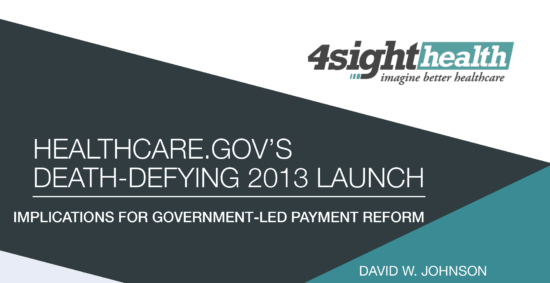November 9, 2016

HealthCare.Gov’s Death-Defying 2013 Launch: Implications for Government-Led Payment Reform
Enrollment for purchasing health insurance on public health exchanges began November 1st. Headlines for this fourth enrollment period include: 22% average price increases; major health insurers dropping coverage; and single companies offering health plans on some exchanges.
While Obamacare is reeling, its Healthcare.gov website functions smoothly. That was not true three years ago when the Obama administration launched HealthCare.gov. Curious consumers overwhelmed the website. It crashed repeatedly and catastrophically.
A “fingers-crossed” editorial cartoon by Pulitzer Prize-winner Clay Bennett captures the website’s underwhelming rollout. HealthCare.gov’s performance was so bad that President Obama considered scrapping its technology platform 17 days after its launch. In a little-known story, a small group of recruited tech wizards worked round-the-clock to resuscitate Obamacare.
HealthCare.gov’s near-death experience raises profound questions regarding the CMS’s (Centers for Medicare and Medicaid Service) ability to manage major value-based payment reform. It also offers several lessons for designing and implementing successful programs.

Code Red
Time Magazine’s March 10, 2014 cover story, “Code Red,” by Steven Brill details the Healthcare.gov fiasco. Obamacare launched nationwide in 36 states on October 1, 2013. The goal was to enroll millions of Americans in new health insurance program with coverage starting as early as January 1, 2014.
The stakes for the Obama Administration and Congressional Democrats were remarkably high. Congressional Republicans shut down the U.S. government from October 1st through the 16th attempting to defund Obamacare. A failed launch could have doomed the President’s signature legislation, emboldened his opponents and tarnished his legacy.
Persuasive marketing had increased the public’s interest in affordable health insurance. A successful launch could have captured the nation’s imagination and burnished his reputation for effective governance.
Administration officials were confident of success. They’d invested 3-plus years and over $300 million building HealthCare.gov. Chief of Staff Denis McDonough told a friend, “When we turn it on tomorrow morning, we’re going to knock your socks off.”
Instead the system cratered. Only 3 in 10 people could access the website and software bugs kicked most of those off it. Few Americans explored their public health insurance options.
The President directed McDonough to evaluate HealthCare.gov’s viability, so he visited CMS operations in Baltimore to get a first-had look. A senior staffer accompanying McDonough described the operations center as “a war zone.”
CMS had no performance dashboards, limited knowledge of website traffic patterns, no metrics for site responsiveness and no answers for why the technology platform was bogging down. It was time for the cavalry to ride to CMS’s rescue.

Silicon Valley to the Rescue
The Administration went into crisis mode. McDonough ordered OMB Deputy Director Jeff Zients and White House Chief Technology Officer Todd Park to find “fresh eyes” to determine whether the system was salvageable.
Despite Park’s deep experience in healthcare technology (he co-foundered Athena Health and Castlight Health), the Administration had not involved him in the design and rollout of the HealthCare.gov website. They focused more on policy and marketing than technology. They worried about getting visitors to the website, not their user-experience once they logged on.
In search of fresh eyes, Zients and Park enlisted a handful of elite engineers with deep experience in designing websites, fixing glitches and engaging consumers. The new recruits’ experience included micro-targeting of prospective voters, re-engineering Twitter’s failing platform, and ensuring product-reliability at Google.
What the new team discovered at HealthCare.gov surprised them. Despite unrelenting negative press and increasingly frustrated consumers, there was no-one in command and no sense of urgency. There were hosts of technical problems. Software didn’t “talk” to other software. The website wasn’t built to scale. Predictable glitches slowed the entire platform to a crawl.
On loan from Google, Mickey Dickerson took charge and determined the HealthCare.gov website was “fixable.” Equally important, Dickerson concluded CMS engineers and contractors working on the site welcomed their help. They wanted to make it work.
There were hosts of technical problems. Software didn’t “talk” to other software. The website wasn’t built to scale. Predictable glitches slowed entire platform to a crawl.
Dickerson established a “war room” outside Baltimore with giant monitors flashing relevant program data. He initiated 45-minute “stand-up” meetings daily at 10 am and 6:30 pm. The morning meetings identified problems. At evening stand-ups, teams reported their progress on solving those problems.
Dickerson posted three rules outside the war room to govern stand-ups:
- No finger-pointing. The stand-ups were exclusively for solving problems;
- Knowledge, not rank, determined who talked. Managers needed to “get out of the way,” so engineers could tackle real problems; and
- Only the most important issues merited discussion.
The team pounded through problems with little sleep. They survived two site crashes and solved thorny technical challenges, such as generating unique ID’s quickly and smoothly for website enrollees.
The team used “two-minute” drills to address scaling challenges. Dickerson brought in Google alum Jini Kim to concentrate on post-enrollment operations. Dubbed the “Queen of Errors,” Kim addressed traffic surges for a rejuvenating HealthCare.gov website.
Progress was slow, steady and then fast. Just under 27,000 individuals enrolled in October, 90% below forecasts. November was much better. User “downtimes” decreased from 57% to 5%. The team executed over 400 “bug fixes.”
As year-end approached, per-click response times had shrunk from a ridiculously-high 8 seconds to a respectable 0.34 seconds. Almost 130,000 enrolled on December 23rd, 5 times the total October enrollment. Although wounded, Obamacare lived to fight another day.

The Perils of Centralized Program Design
During Brill’s research for the “Code Red” article, he found a dozen people who claimed managerial responsibility for HealthCare.gov’s. Nobody was truly in charge. High-level policy-makers had no understanding of the operational changes required to launch a fully-functional website.
Senior leaders stressed marketing. Their operating assumption seemed to be that “someone else would make it work.” There were multiple turf wars and a lack of honest information-sharing.
The HealthCare.gov experience illustrates the dangers of government-led, centralized product design and deployment. In healthcare, entire industries (e.g. revenue cycle consulting) have emerged to interpret and optimize CMS payment formularies and regulations. Too often, process trumps outcomes. Payment is a function of what providers do, not how well they do it.
Old habits die hard. As CMS moves toward value-based payment initiatives, it is relying on complex formularies, multiple performance metrics and intricate payment reconciliation mechanics. MACRA, bundled payment, the Oncology Care Management and other value-based payment models require burdensome data collection and reporting.
CMS technicians confuse process fulfillment with outcomes measurement. Checking boxes does not guarantee better performance.

Lessons Learned
Given the high stakes, it’s remarkable that the Obama administration required last-minute intervention to get HealthCare.gov up and running. Launching a website is not “sending a man to the moon.” The government had ample time and funding to design, test and implement a successful launch. Instead, the Obama Administration misfired and shot itself in the foot.
HealthCare.gov’s self-inflicted wounds were clearly preventable. As CMS strives to implement comprehensive “value-based” payment reform, it is essential that its administrators to absorb the following “lessons:”
- Execution Determines Policy Life or Death: there’s an old adage that “culture eats strategy for breakfast.” A government corollary is “execution eats policy for lunch.” The best policies will fail without effective program design, testing and implementation.
- It’s the Customer Stupid: government programs assess broad program impact and neglect individual experience. Unlike companies, governments don’t depend upon customers for survival. This operating reality means governments have to work extra hard to hear the “customer’s voice” when developing and implementing programs.
- Success Requires Clear Leadership and Accountability: all great organizations have an operations leader who makes the “trains run on time.” HealthCare.gov had a gaping leadership void. There was no direction and limited accountability. Talented engineers floundered and began finger-pointing. Time and resources evaporated.
Jeff Zients, Todd Park and Mickey Dickerson brought structure, discipline and operating freedom to HealthCare.gov. Engineers “worked” the right problems in the right way. Jini Kim emphasizes Park’s ability to shield the engineers from external distractions. She says Park had an impenetrable “crap umbrella.”
- Outcomes Trump Process: centrally-administered programs have a penchant for process management and excessive data collection. This is how bureaucracies sustain themselves and grow. Instead, governments should establish outcome goals and let the marketplace allocate resources.
For example, governments now score health-risk assessment for defined populations and attribute those lives to participating health insurers in Medicare Advantage and other risk-based payment programs.
Governments could achieve better outcomes by pre-qualifying health insurers, setting program guidelines, sharing relevant de-identified patient information and letting individual companies bid to provide health insurance to defined populations.
- Take Advantage of Outside Expertise: CMS leadership had no idea how to launch a consumer-oriented program and lacked the humility to acknowledge this reality. Governments should evaluate their core competencies and seek partners for essential functions where they lack expertise.
American healthcare cannot afford more HealthCare.gov execution fiascos. Government leaders should target improved outcomes and take advantage of marketplace expertise it lacks. CMS should worry about reducing heart attacks, not the 27 different items they believe will reduce heart attacks. Reward providers that perform. It’s the American way.





